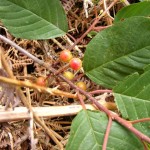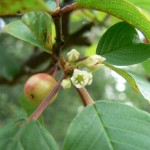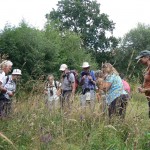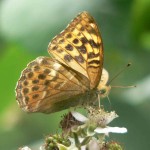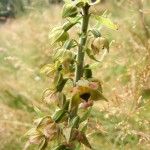Michael Keith-Lucas led a walk at Pamber Forest on Sunday 28th July. A Crab Apple tree, an ancient woodland indicator species, was growing at the entrance to the wood. It had shiny, hairless leaves. Another specimen later on also had small rounded fruits. Towards the end of the walk, a domesticated apple tree was spotted, and this had downy undersides to its leaves. Pamber has both Pedunculate and Sessile Oaks, and Michael pointed out the key differences. The leaves of the Pedunculate Oak have a short stalk and rounded basal lobes, while the acorns have a long stalk. The Sessile Oak has longer-stalked leaves with more side lobes and a tapering base, while the acorns are virtually stalkless. The walk started out along the wood bank which marks the boundary between the ancient forest and the heathland of Silchester Common. Common Cow-wheat, a partially parasitic plant, was in flower next to the path. Apparently it can be an indicator of sites where woodland has been cleared by burning in the past. A Wild Service-tree, with berries forming, was spotted.
The route continued across the Common and down into one of the valley mires, where the ground had been badly poached by cattle. Bog Asphodel, Marsh Violet with kidney-shaped leaves, Marsh St John’s-wort, Bog Pimpernel, Lesser Skullcap and Common Cottongrass were amongst the finds here. There were also a number of different sedges and rushes, including Star Sedge, Small-fruited Yellow Sedge and Bristle Club-rush. Cross-leaved Heath was found in the valley bottom, while Bell Heather flowered in profusion up on the drier ridge. Dwarf Gorse, lighter green and with less robust prickles than common Gorse, was just coming into flower. Continuing along the path, flowering Dodder, Lily-of-the-valley and Wood Horsetail were seen. The Alder Buckthorn bushes had been severely browsed by the cattle. A few had both flowers and berries, but these only survived at the top of the tallest branches.
The route then led back into the forest, where two female Silver-washed Fritillary butterflies were resting on bracken. A shady damp valley in the woodland had Yellow Pimpernel, Enchanter’s Nightshade, Common Valerian and both Narrow and Broad Buckler-fern. Continuing along a more open section, most of the grass in the centre of the ride had been cut and raked. A group of flowering Broad-leaved Helleborines and a big clump of Betony had been left uncut. The purple Betony flowers were a magnet for bees and skipper butterflies. A single White Admiral and a good number of Silver-washed Fritillary butterflies were seen. A clump of Nettles at the side of path with longer narrower leaves were identified as the non-stinging variety Urtica dioica ssp galeopsifolia. Finally, a number of Gatekeeper butterflies were seen on the hedge next to the allotments.
Pictures by Rob Stallard and Laurie Haseler
RDNHS trip Pamber Forest and Silchester Common
Plant species and Fungi in sequence as seen:
Wood (Pamber Forest):
| Quercus robur | Pedunculate Oak |
| Malus sylvestris ssp. Sylvestris | Crab Apple |
| Vaccinium myrtillus | Bilberry |
| Pteridium aquilinum | Bracken |
| Melampyrum pratense | Common Cow-wheat |
| Molinia caerulea | Purple Moor-grass |
| Holcus mollis | Creeping Soft-grass |
| Quercus petraea | Sessile Oak |
| Chlorociboria aeruginascens | Green Wood-cup |
| Sorbus aucuparia | Rowan |
| Sorbus torminalis | Wild Service-tree |
Heath (Silchester Common):
| Calluna vulgaris | Heather |
| Erica tetralix | Cross-leaved Heath |
| Hypericum pulchrum | Slender St John’s-wort |
| Potentilla erecta | Tormentil |
| Digitalis purpurea | Foxglove |
| Polytrichum commune | |
| Juncus bulbusus | Bulbous Rush |
| Juncus articulates | Jointed Rush |
| Carex echinata | Star Sedge |
| Carex viridula ssp. viridula | Small-fruited Yellow Sedge |
| Juncus conglomeratus | Compact Rush |
| Juncus effuses | Soft-rush |
| Hydrocotyle vulgaris | Marsh Pennywort |
| Isolepis setacea | Bristle Club-rush |
| Cirsium palustre | Marsh Thistle |
| Viola palustris | Marsh Violet |
| Ranunculus flammula | Lesser Spearwort |
| Lotus pedunculatus | Greater Bird’s-foot-trefoil |
| Anagallis tenella | Bog Pimpernel |
| Hypericum elodes | Marsh St John’s-wort |
| Scutellaria minor | Lesser Skullcap |
| Narthecium ossifragum | Bog Asphodel |
| Eriophorum angustifolium | Common Cottongrass |
| Frangula alnus | Alder Buckthorn |
| Erica cinerea | Bell Heather |
| Ulex minor | Dwarf Gorse |
| Cuscuta epithymum | Dodder |
| Equisetum sylvaticum | Wood Horsetail |
| Ulex europaeus | Gorse |
| Convallaria majalis | Lily-of-the-valley |
| Agrostis capillaris | Common Bent |
| Juncus tenuis | Slender Rush |
| Athyrium filix-femina | Lady-fern |
| Dryopteris dilatata | Broad Buckler-fern |
| Circaea lutetiana | Enchanter’s-nightshade |
| Oxalis acetosella | Wood-sorrel |
| Carex remota | Remote Sedge |
| Lysimachia nemorum | Yellow Pimpernel |
| Dryopteris carthusiana | Narrow Buckler-fern |
| Valeriana officinalis | Common Valerian |
| Blechnum spicant | Hard Fern |
| Carex pallescens | Pale Sedge |
| Lonicera periclymenum | Honeysuckle |
Back in Pamber Forest:
| Ajuga reptans | Bugle |
| Cirsium palustre | Marsh Thistle |
| Euphorbia amygdaloides | Wood Spurge |
| Epipactis helleborine | Broad-leaved Helleborine |
| Stachys officinalis | Betony |
| Lysimachia nummularia | Creeping-Jenny |
| Rumex conglomeratus | Clustered Dock |
| Urtica dioica ssp. galeopsifolia | Fen Nettle (non-stinging) |
| Alnus cordata | Italian Alder |
| Prunus spinosa | Blackthorn |
| Rumex obtusifolius | Broad-leaved Dock |
Butterflies
Silver-washed Fritillary
White Admiral
Large Skipper
Comma
Gatekeeper
List by Renée Grayer


